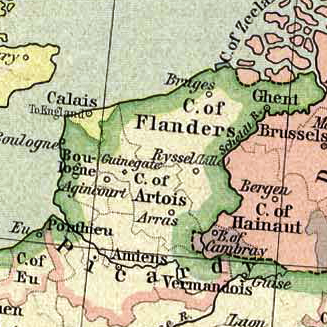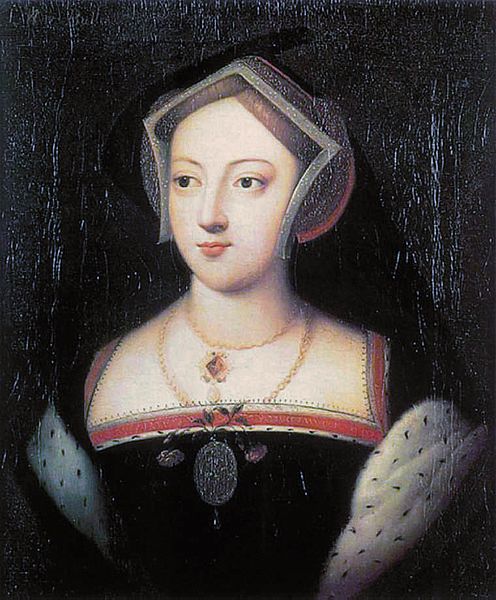 |
| Catherine of Aragon |
A Case
of Conscience
In northern Europe the
influence of Martin Luther
was spreading fast. Following his nailing his Ninety Five Theses to the door of All Saint’s church in Wittemburg
in 1517 the Protestant Reformation had grown on the back of dissatisfaction with the
corruption within the Catholic church. And now an
unconsummated affair between Henry and one of his wife’s ladies-in-waiting was
to kick off a series of events that was to see the throwing off of the Catholic
Church’s mantle in England.
Henry fell in love with Anne
Boleyn and when she failed to jump into his bed, he became obsessed with her.
Queen Katherine was clearly at fault for failing to produce a male heir and now
Wolsey was put under pressure to get Katherine off Henry’s hands so he could
marry Anne. Katherine’s marriage to
Henry’s brother Arthur now worried
Henry’s conscience so that he was unable to remain married to his queen.
 |
| Thomas Cranmer |
In 1527 Wolsey was
commissioned to get the marriage annulled on the grounds that Katherine had slept with Arthur
and therefore the marriage between Henry and Katherine should never have taken
place. On 18th May 1527 the new Spanish ambassador reported that
Henry had;
‘Secretly assembled certain bishops and
lawyers that they may sign a declaration to the effect that his marriage with
the Queen is null and void on account of her having been his brother’s
wife…..[the King] was bent on this divorce.’[i]
Unfortunately for Henry the pope was a prisoner of
Katherine’s nephew Emperor Charles, who was not prepared to see his aunt
humiliated. The annulment was not granted and now, with the support of Thomas Cranmer,, Henry
decided that the only answer was to divorce himself and his country from the
religious overlordship of Rome.
With his
failure to ensure a divorce from Queen Catherine Wolsey fell out of favour and
by the end of 1530 Wolsey was dead and his secretary Thomas Cromwell was chosen to take a seat on the Privy Council.
A Trip to Calais
 |
| Anne Boleyn |
In October 1532
Henry set out on a journey to Calais; his objective was to meet with François
again. In Henry’s train came Anne Boleyn, now a peer in her own right as Marchioness of Pembroke, in place of Queen Katherine who had
been set aside and was living at Enfield. Honor was one of six ladies chosen to
accompany Anne Boleyn along with Anne’s sister Mary, Lady Rochford[ii], Lady Mary Howard[iii], Dorothea Howard[iv] Countess of Derby and Elizabeth, Lady Fitzwalter[v].
Henry set up
in residence at the Exchequer Palace and he and Anne had interconnecting rooms.
In discussions with Henry François showed himself sympathetic to the nullity
suit. On 27th, Anne and her six ladies took part in a masque to
entertain the kings; Anne was dressed in cloth of gold slashed with crimson
satin, puffed with cloth of silver and laced with gold cords. Her ladies wore
loose gowns of cloth of gold slashed with crimson tinsel laced in gold and all
of them wore masks.
When the
dance was finished Anne led François out to dance. Mary Boleyn asked Henry to
dance while the other ladies invited other gentlemen present to join them. The
following day the two kings joined a chapter meeting of the Order of the
Garter, which Arthur would have attended if he was part of Henry’s entourage.
On 29th
October Henry escorted François to the French border where they made their
farewells and went their separate ways. For Henry that was back to Calais and
Anne where they dallied for a further fortnight.
It was not
until January 1533 that Anne Boleyn finally got her way and was secretly married
to the king of her choice. But it was probably in Calais that she first allowed
Henry into her bed and by December she was pregnant. In February Anne had,
according to Thomas Wyatt,
‘An inestimable wild desire
to eat apples, such as she had never had in her life before, and the king told
her it was a sign she was with child, but she said it was nothing of the sort.’[vi]
Arthur acted
as Chief Panter[vii]
at the banquet celebrating the marriage.
Although
Henry and Anne were married, Henry was well aware that he was not married in
the eyes of Rome and Elizabeth, born on 7th September
1533, was viewed as a bastard. By November 1534, infuriated by the Catholic
church’s refusal to give him what he wanted, under the Act of Supremacy, Henry separated from Rome, creating
the Church of England with himself as its supreme governor and Cranmer as head prelate and Archbishop of Canterbury.
Calais
 |
| Pale of Calais |
The mayor Sir Richard Whetwill, of an old Calais family, was to prove particularly troublesome to Arthur. Another troublemaker was Sir Robert Wingfield, a member of the Calais council. Whetwill insisted that his son Richard should have priority, something which Arthur, for all his easy going ways, resisted and the resultant quarrel saw all Calais take sides.
On his side Arthur had his man of business, John Husee, a merchant who managed Arthur’s affairs in England while he was absent in France. Husee became Arthur’s agent in August 1533; He carried letters from Calais to England, and kept Lord Lisle informed of political events at court.
Much of Husee’s time was spent in England following Lord Lisle's suits at law. Husee was particularly adept at relations with those in the upper echelons of power, and even at times offered Arthur advice on dealing with King Henry VIII. Husee performed more mundane tasks for the Lord Deputy and his family as well, seeing to the care of Honor's children by her first marriage;
‘By Swift I sent a cap with a white feather in a
cap case for Mr [John] Bassett, which I trust is there ere this time….Mr Popley
lent me XX nobles, whereof I think he doth owe the best part for his rent.,
which I paid for the furring of Mr Basset’s gown.’[ix]
Husee was compensated for his services with a post in the Calais garrison which by 1535 provided him with a daily wage of 8d[x]. In October 1536 he received a grant for life from the Crown as 'searcher of the lordships of Marke and Oye within the Calais pale', which brought him an additional 8d a day.
An Unimportant Spearman
 |
| Mary Boleyn |
When Arthur
arrived in Calais one William Stafford joined the garrison as a spearman.
Stafford was soon being used by the Lisles as a courier between Calais and
England and running commissions for the family. In December 1533 Husee met with
Stafford in Dover; Stafford had been in England to purchase a gorget, ribbon and lawns for Honor. In August 1534 a correspondent of Honor’s
wrote to her;
‘Since my coming from London
from Hampshire, I hear that Stafford your servant, to whom I gave the letter,
was in London long after, so I wish to know whether it has been received.’[xi]
Stafford, a
relatively unimportant manservant probably met up with Mary Boleyn, to further
his romance with the Queen’s sister, a woman who was not prone to thinking of
the consequences of her actions. Stafford and Mary probably married in the
summer of 1534. Mary had been living under her father’s displeasure[xii] since the death of her first
husband. This marriage to Stafford was seen as a great mésalliance, making the
king brother-in-law to a common spearman. Certainly the couple were never
received at court again.
There is
evidence to show that Stafford retained his place with the Lisles, as mention
is made in letters to Honor and Arthur of their man Stafford running errands for
themselves and their friends. It is assumed that Mary joined him in Calais,
though not with the children of her previous marriage; her son was taken by Anne
as a ward. Thomas Boleyn was every bit as disapproving as his younger daughter
and it is unlikely that they were ever reconciled.
Bibliography
The Lisle
Letters – Muriel St Clare Byrne, Penguin Books 1985
The Royal
Bastards of Medieval England – Chris Given-Wilson and Alice Curteis, Barnes and
Noble Inc. 1984
The Ebbs and
Flows of Fortune – David M Head, University of Georgia Press 2009
Thomas
Cromwell – Robert Hutchinson, Phoenix 2008
Henry VIII –
Robert Lacey, Weidenfeld & Nicholson and Book Club Associates 1972
The Earlier
Tudors – JD Mackie, Oxford University Press 1992
Thomas More
– Richard Marius, Weidenfeld & Nicholson 1993
Six Wives –
David Starkey, Chatto & Windus 2003
The Six
Wives of Henry VIII – Alison Weir, Pimlico 1992
Mary Boleyn
– Alison Weir, Vintage 2012
www.en.wikipedia
[i]
Six Wives - Starkey
[ii]
Anne’s sister-in-law
[iii]
The Duke of Norfolk’s daughter, Anne’s cousin and later Duchess of Richmond
[iv]
Mary’s sister
[vi]
The Six Wives of Henry VIII - Weir
[vii]
An honorary positon as head of the royal pantry
[viii]
Formerly the Inn of the Staplers’ Company
[ix]
The Lisle Letters – Byrne
[x]
Per annum
in 2014 the relative: historic standard of living
value of that income or wealth is £6,603.00 economic status value of that income or wealth is £216,700.00 economic power value of that income or wealth is £2,936,000.00 www.measuringworth.com
[xi]
Mary Boleyn - Weir
[xii]
Henry had forced Thomas to pay for Mary’s upkeep and house her
You mention that Rob Wingfield was a trouble, I would be interested to know in what way [beyond being certain that he was as ornery as they come as the Wingfields are an Ipswich family]
ReplyDelete